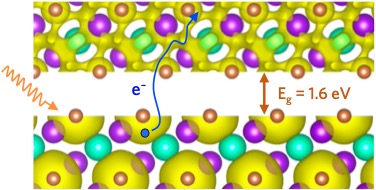Relativistic electronic structure and photovoltaic performance of K2CsSb

Solar cells are a promising renewable energy source due to theirability to convert sunlight into electricity without a negative impact on theenvironment. Most commercial photovoltaics are made from silicon but there is ademand for alternative technologies with greater efficiency and reduced cost. Theearth-abundant and non-toxic material K2CsSb has been studied as a thermoelectricand photocathode, yet its suitability as a photovoltaic has not been explored. Throughtheoretical calculations, we reveal that K2CsSb exhibits ideal propertiesfor use as the absorber layer in solar cells. In particular, it possesses aband gap of 1.6 eV, strong visible light absorption, and a highly delocalised specialsponge-like electron density leading to favourable electronic transport. Themaximum theoretical light conversion efficiency is predicted to reach over 28%for a 200 nm thin film, which is competitive with other emerging photovoltaics suchas the lead hybrid halide perovskites.
Authors: Authors: Ruiqi Wu; Alex M. Ganose
